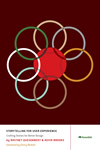A review of

 Storytelling for User Experience: Crafting Stories for Better Design
Storytelling for User Experience: Crafting Stories for Better Design
by Whitney Quesenbery & Kevin Brooks
Rosenfeld Media, 2010
and
UX Storytellers: Connecting the Dots
Edited by Jan Jursa, Stephen Köver, & Jutta Grünewald, http://uxstorytellers.blogspot.com
Storytelling is one of our primary communication skills as human beings. We have sat in front of prehistoric campfires and modern-day e-books, absorbing with interest and amazement the wisdom, wit, humor, and sadness described, soaking up facts, concepts, and emotions. Little wonder that two recent books with different premises both focus on
storytelling in relation to the topic of user experience
The theme of UPA’s 2006 conference was “Usability Through Storytelling.” The conference announcement stated: “Observing and analyzing users and their tasks creates stories that will bring the user community alive in the minds of others.” Kevin Brooks, a researcher at Motorola Labs and a professional storyteller, was the closing plenary speaker. He has teamed up with Whitney Quesenbery to write a book about how to use storytelling in the development of usable, useful, and engaging products and services.
Each of us has faced the need to explain to one’s own team, or others, what we are doing and why. We all use stories to inform, describe, persuade, explore, and inspire. Our stories help us better understand our users, learn about their objectives and goals, explain the results of our research, and demonstrate our design ideas. Facts, concepts, and emotions together help us communicate ideas effectively in order to get people “on the same page” and to achieve buy-in for our objectives. Storytelling for User Experience sets forth all the key principles of practice in a succinct, compelling narrative.
The book is divided into three parts:
1. Explaining why stories can be useful and why they work, including ethical considerations when using stories about real people.
2. A review of the user experience development process, showing how stories can help each step, from research to evaluation.
3. Detailed writing and use issues, including selecting the correct audience, ingredients (perspective, character, context, imagery, and language), framework (structure and plot), and medium (oral, written, visual, performance, mixed-media).
To its credit, the book is written and laid out in a readable, “thick, chunky” format, like delicious peanut butter. You can dive in almost anywhere and find guidelines, citations to further useful information, and examples that help you see the point and understand what the principles mean in practice. My only minor lament is the scarce use of visuals that might have enhanced the text; but then the book’s orientation is more toward verbal storytelling than visual. That quibble aside, I applaud its reference to Scott McCloud’s Understanding Comics, and the graphics it does include in its visual storytelling section.
All in all, this is a very useful guide for what most professionals sense they do frequently. Here is professional expertise and experience set forth clearly to help you understand more and do better on your next project.
And now, for something related but completely different. Jan Jursa, Stephen Köver, and Jutta Grünewald have put together a collection of the reminiscences, horror stories, comical recountings, and insightful memoirs of approximately fifty professionals from around the world. As Jursa describes it in the book, “UX masterminds, authors, and big thinkers tell entertaining stories about user experience, information architecture, and usability.” One can easily view the authors list, select well-known names or lesser known figures, and spend a few minutes, or hours, within their minds (full disclosure, I am one of the contributors).
In three loosely convened chapters you can find just about anything and everything, from the UX development process, tools, how to deal with clients, life in agencies, and descriptions of projects, to the proverbial sex, drugs, and rock-and-roll. The book is an informative, entertaining mish-mash and substantive contribution of the authors, more than just the anecdotal snippets you might have caught part of from some previous conference or social situation.
The texts are more than just cocktail party stories, and far from academic analyses of challenges encountered and, perhaps, solved. Admittedly, the writing styles, structure, pacing, and detail vary. Thankfully, an eight-page index allows the reader to search for topics of interest and to find references that may involve several storytellers. Nevertheless, professionals of every kind in the UX-related fields are certain to find valuable nuggets and “aha!” moments in reading through this marvelous and impressive collection of stories.
